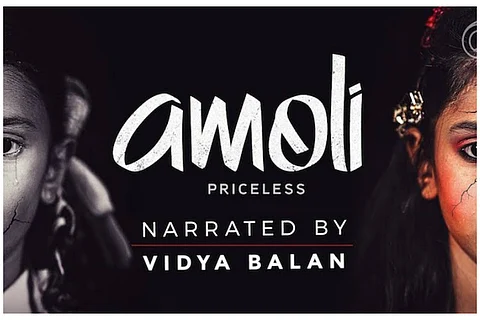

The first frame of the movie, Amoli: Priceless, goes straight to Delhi’s famed GB Road. After a short struggle, the police in plainclothes managed to open a small door leading to a narrow passage. Inside were three children facing the wall, their fear palpable. The shaky footage shot on a hand-held camera by the team of police and members of an NGO makes the viewer part of the ‘raid’. “We are the police, we are here to rescue you. We are not here to harm you,” a cop tells the children whose bodies have clearly frozen in fear. The fear turns into panic as the children start frantically screaming and refuse to come out. The single frame captures a lot of things - how raids are conducted by the police, the fear and trauma that children trapped in prostitution experience and the sheer helplessness of the state’s inability to protect its children.
Cut from the dingy streets of Delhi, the camera pans to the lush green fields of Jalpaiguri and subsequently to other parts of northern India. Whether in Madhya Pradesh or Bihar, the country’s beauty is captured aesthetically. But beneath the veneer of lush greenery and misty clouds, India’s most perverted secrets are unwrapped, one child at a time. The movie was shot between January and March. “We wanted to juxtapose the landscapes of rural India and the horror it hides,” said national award-winning director Jasmine Kaur Roy.
The directors, Jasmine Kaur Roy and Avinash Roy, attempt to capture the magnitude of commercial sexual exploitation of children. It is estimated that between 24 lakh and 36 lakh children are currently trapped in child trafficking. There is a child getting trapped in this trade every eight minutes, the documentary informs the viewer. But the duo go beyond these numbers. These are the only numbers presented throughout the movie. Talking to The News Minute, they open up about what they learnt and the challenges they faced while documenting child trafficking. “The police may be sensitised. They may follow all protocols during a raid. But the criminals are always one step ahead. Being an unorganised sector, and with families willingly selling their daughters, it becomes difficult for the police to keep track,” said Jasmine Kaur Roy. “Very often, the age of the girls in their documents are forged. The traffickers are constantly changing the routes on which the girls are taken. It becomes very difficult for the police to nab criminals,” she added.
Along the 100km stretch between the districts of Neemuch and Mandsur in Madhya Pradesh, selling children to ‘agents’ for commercial sexual exploitation has become a tradition - where aunts, uncles and even parents sell their children. “The girl’s family is boycotted by the village if the girl refuses. If a family has two girl children, it is decided at birth which one would be sold and which one would be married off,” said Avinash Roy. The average age of girls being sold into prostitution is between 12 and 13. “At the age of 11, they are sent on a one-year “internship” with older girls to understand how the trade works,” he added.
The directors of the movie said that just the government or the police cannot be held responsible for failing to protect India’s children. “It is a collective failure of the society. As long as there is demand for children, the trade will flourish. The customer has to be caught and punished,” said Avinash Roy. “The idea behind the movie was to capture the enormity of the trade, bring awareness to the masses. Most of us live in denial because we believe it does not affect us,” he added.
Past the 22-minute mark in the documentary, there is a long shot of what seems to be a school surrounded by coconut trees and other vegetations. “Bharath mera desh hai. Sabhi Bharath vaasi mere bhai-behen hai. Mujhe apna desh se pyaar hai. (India is my country. All Indians are my brothers and sisters. I love my country,” a group of children can be heard chanting in chorus. These words ring hollow.
The 30-minute documentary was produced by Culture Machine and was released on May 7, 2017 in seven languages.